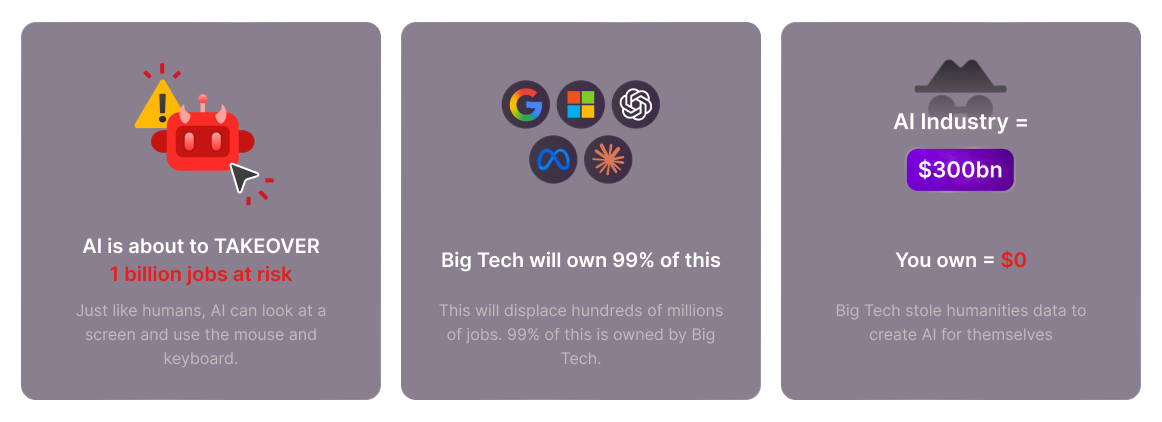The Scale of Disruption
The world stands at the precipice of the most significant workforce transformation in human history. Over 1 billion people globally are employed to work behind computers, performing tasks that AI agents are rapidly learning to automate. This isn’t a distant future, it’s happening now.
1+ Billion
$920 Billion
68.7%
The Computer Work Revolution
Who Will Be Affected?
Every job that primarily requires three simple tools is at risk:- Looking at a screen 👁️
- Using a mouse 🖱️
- Using a keyboard ⌨️
The Data Behind the Disruption
| Metric | Number | Percentage | Source |
|---|---|---|---|
| Knowledge Workers Globally | 644–997 million | 19.6–30.4% of global employment | UN/ILO 2023 |
| Alternative Estimate | 1+ billion | ~30% of workforce | Gartner/Forbes |
| EU Computer Workers | ~30% | 30% of EU workforce | Eurostat 2023 |
| Global Internet Users | 5.65 billion | 68.7% of world population | DataReportal 2025 |
The Economic Inevitability
Why Businesses Will Choose AI
The economics are undeniable. When an AI agent can perform the work of 3-5 human employees at 95% less cost, businesses face a simple calculation:- Human Employee
- AI Agent
- Cost: $50,000-100,000/year per employee
- Availability: 40 hours/week, sick days, vacation
- Scalability: Linear hiring costs
- Training: Weeks to months per new hire
- Consistency: Variable performance
Jobs Most at Risk
Non-Technical Roles Leading the Displacement
Contrary to popular belief, it’s not just entry-level positions at risk. The most vulnerable jobs are those involving:Administrative & Clerical Work
Administrative & Clerical Work
- Data entry specialists
- Administrative assistants
- Bookkeepers and accounting clerks
- Scheduling coordinators
- Document processors
Customer Service & Support
Customer Service & Support
- Call center representatives
- Email support agents
- Chat support specialists
- Technical support (Level 1-2)
- Order processing staff
Marketing & Content Creation
Marketing & Content Creation
- Social media managers
- Content writers
- SEO specialists
- Email marketing coordinators
- Campaign managers
Finance & Analysis
Finance & Analysis
- Financial analysts (junior/mid)
- Report generators
- Compliance checkers
- Risk assessors
- Budget analysts
Sales & Business Development
Sales & Business Development
- Lead qualification specialists
- CRM managers
- Proposal writers
- Market researchers
- Sales development representatives
The Timeline Is Accelerating
Why Now?
Several factors are converging to accelerate this transformation:LAM Technology Breakthrough
Economic Pressure
Proven Success Cases
Infrastructure Readiness
The Wealth Concentration Crisis
Where Will the Money Go?
As jobs disappear, the economic value doesn’t vanish, it concentrates:
The flow of wealth from displaced workers will inevitably move to Big Tech
The Human Impact
Beyond the Numbers
Behind every statistic is a human story:- Career professionals with decades of experience finding their skills suddenly obsolete
- Recent graduates entering a job market that no longer exists
- Entire communities built around knowledge work facing economic collapse
- Developing nations losing their competitive advantage in service outsourcing
What This Means for You
The Uncomfortable Truth
Office & Administrative Support
Office & Administrative Support
- Receptionists (front desk)
- Travel coordinators
- HR onboarding specialists
- Payroll processing staff
- Vendor management assistants
- Inventory clerks (digital tracking)
- Document archivists and file managers
Finance & Accounting
Finance & Accounting
- Tax preparers (basic returns)
- Accounts payable/receivable clerks
- Audit support analysts
- Financial statement compilers
- Expense report processors
- Budget tracking coordinators
- Regulatory compliance officers (routine checks)
Sales & Business Development
Sales & Business Development
- Lead researchers and prospecting specialists
- CRM data entry managers
- Follow-up email automation handlers
- Pricing strategy assistants
- Market intelligence gatherers
- Competitive analysis reporters
Marketing & Content Operations
Marketing & Content Operations
- Blog content schedulers
- SEO audit coordinators
- Meta tag optimizers
- A/B testing analysts (basic)
- Campaign performance trackers
- Social media comment responders
- Email list segmenters and cleaners
IT & Technical Support
IT & Technical Support
- Helpdesk Tier 1 support agents
- Password reset specialists
- Ticket triage clerks
- System monitoring watch staff
- Basic network troubleshooting assistants
- Software update coordinators
Healthcare & Medical Administration
Healthcare & Medical Administration
- Medical billing coders (ICD-10, CPT)
- Patient appointment schedulers
- Insurance verification agents
- Health records entry personnel
- Claims submission processors
- Pharmacy inventory trackers
Legal & Compliance Support
Legal & Compliance Support
- Document redaction specialists
- Case file organizers
- Legal research assistants (routine queries)
- Contract reviewers (standard clauses only)
- Discovery data prep workers
- Regulatory form fillers
Education & E-Learning
Education & E-Learning
- Online course content uploaders
- Quiz generator admins
- Student enrollment coordinators
- Gradebook maintainers
- LMS (Learning Management System) support staff
- Tutorial video captioners and editors
Real Estate & Property Services
Real Estate & Property Services
- Rental listing creators and updates
- Tenant screening assistants
- Lease document processors
- Property inspection report writers
- Maintenance request organizers
- Title search coordinators
Supply Chain & Logistics
Supply Chain & Logistics
- Order fulfillment clerks
- Delivery schedule managers
- Inventory status reporters
- Shipment tracking analysts
- Packaging label generators
- Customs documentation preparers
Publishing & Journalism (Entry-Level)
Publishing & Journalism (Entry-Level)
- News summary writers
- Press release editors
- Fact-checking assistants (basic)
- Content repurposers (e.g., turning blog posts into tweets)
- Subtitle and transcript creators
- Data visualization journalists (template-based)
Creative Services (Repetitive Tasks)
Creative Services (Repetitive Tasks)
- Logo redesign helpers (based on templates)
- Social media image batch editors
- Video thumbnail generators
- Stock photo taggers
- Basic graphic design assistants (Canva, Figma workflows)
- Brand style guide maintainers
The Path Forward
Two Possible Futures
We stand at a crossroads with two distinct paths:Path 1: Big Tech Monopoly
Path 2: Community Ownership
The Resistance Begins
The displacement is inevitable, but who benefits from it is not. Action Model represents the uprising, a chance for the very people whose jobs are being automated to own a piece of the AI future.Become a part of the AI Future

Join the Action Model Resistance